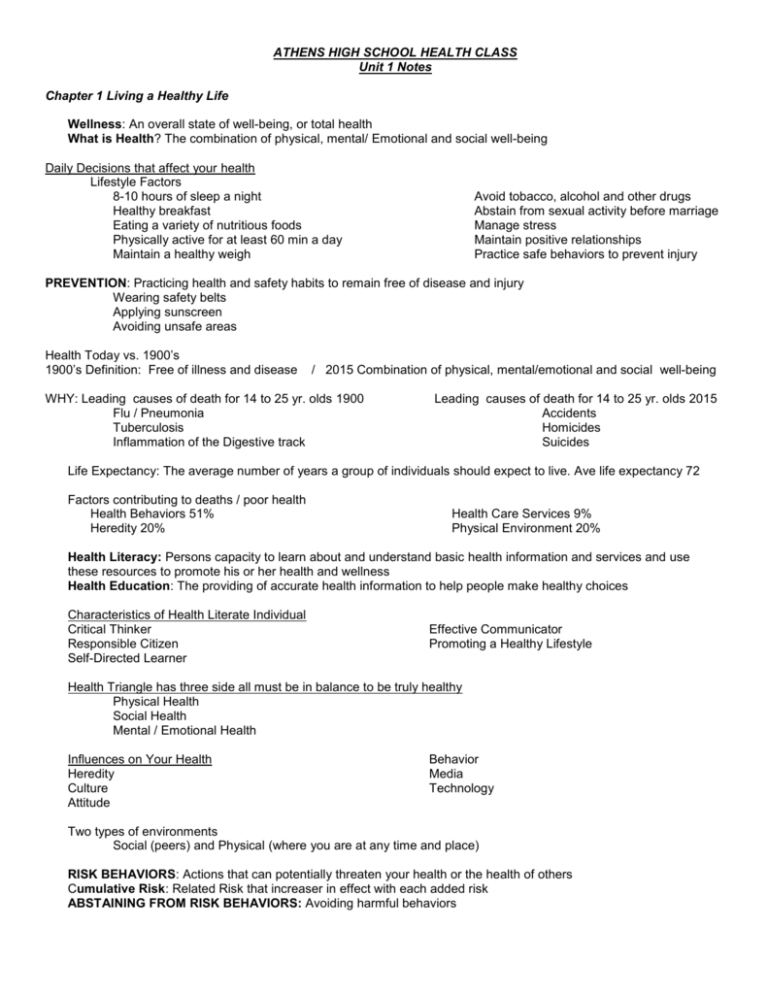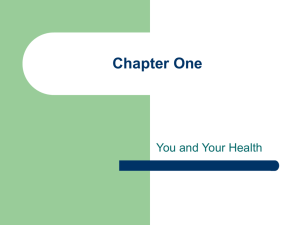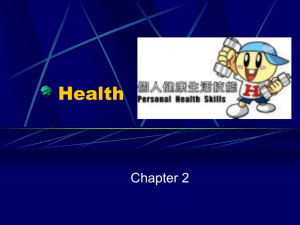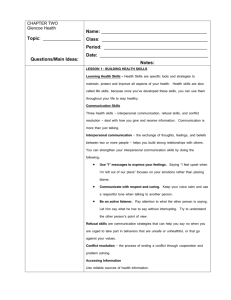ATHENS HIGH SCHOOL HEALTH CLASS Unit 1 Notes Chapter 1
advertisement

ATHENS HIGH SCHOOL HEALTH CLASS Unit 1 Notes Chapter 1 Living a Healthy Life Wellness: An overall state of well-being, or total health What is Health? The combination of physical, mental/ Emotional and social well-being Daily Decisions that affect your health Lifestyle Factors 8-10 hours of sleep a night Healthy breakfast Eating a variety of nutritious foods Physically active for at least 60 min a day Maintain a healthy weigh Avoid tobacco, alcohol and other drugs Abstain from sexual activity before marriage Manage stress Maintain positive relationships Practice safe behaviors to prevent injury PREVENTION: Practicing health and safety habits to remain free of disease and injury Wearing safety belts Applying sunscreen Avoiding unsafe areas Health Today vs. 1900’s 1900’s Definition: Free of illness and disease / 2015 Combination of physical, mental/emotional and social well-being WHY: Leading causes of death for 14 to 25 yr. olds 1900 Flu / Pneumonia Tuberculosis Inflammation of the Digestive track Leading causes of death for 14 to 25 yr. olds 2015 Accidents Homicides Suicides Life Expectancy: The average number of years a group of individuals should expect to live. Ave life expectancy 72 Factors contributing to deaths / poor health Health Behaviors 51% Heredity 20% Health Care Services 9% Physical Environment 20% Health Literacy: Persons capacity to learn about and understand basic health information and services and use these resources to promote his or her health and wellness Health Education: The providing of accurate health information to help people make healthy choices Characteristics of Health Literate Individual Critical Thinker Responsible Citizen Self-Directed Learner Effective Communicator Promoting a Healthy Lifestyle Health Triangle has three side all must be in balance to be truly healthy Physical Health Social Health Mental / Emotional Health Influences on Your Health Heredity Culture Attitude Behavior Media Technology Two types of environments Social (peers) and Physical (where you are at any time and place) RISK BEHAVIORS: Actions that can potentially threaten your health or the health of others Cumulative Risk: Related Risk that increaser in effect with each added risk ABSTAINING FROM RISK BEHAVIORS: Avoiding harmful behaviors Chapter #2 Building Health Skills and Character Health Skills Specific tools and strategies that help you maintain, protect, and improve all aspects of your health Interpersonal Skills Exchange of thoughts, feelings and beliefs between two or more people Interpersonal Skills Pay attention to how you say things Use a respectful tone Verbal / Nonverbal Communication Refusal Skills Say NO in a firm Voice Explain Why Suggest Alternatives Be a good listener Avoid interrupting the speaker Use appropriate body language Leave if necessary Conflict Resolution Skills The process of ending a conflict through cooperation and problem solving Key is respecting others rights and your own Take time to calm down and think through situation When discussing conflict, speak calmly and listen attentively, asking questions when appropriate Use a polite tone and brainstorm solutions Self-Management Skills Practice healthful behaviors Eat nutritious meals Avoid use of tobacco Manage Stress Learn stress management skills Analyzing Influences Internal Influences: Your knowledge, values, likes, dislikes, and desires External Influences: Your family, friends, peers, culture, laws, media Accessing Information Reliable Sources of Health Information parents, guardians, and other trusted adults library resources reliable internet sites newspapers and magazine articles by health professionals government agencies, health care providers, and health organizations Making Responsible Decisions and Setting Goals Decision Making Process I. State the situation II. List the options III. Weigh possible outcomes (H.E.L.P.) Healthful - what health risk will this option present Ethical - Does this choice reflect what you and your family believe is right Legal - Does this option break any laws Parent Approval - Would parents approve of this choice IV. Consider Values V. Make a decision and act VI. Evaluate the Decision Types of Goals Short Term - reached in a short period of time Long Term - goal that you plan to reach over an extended period of time. Achieving Your Goals ACTION PLAN (S.M.A.R.T.) Specific - be specific about what you want to accomplish Measurable - If you can’t measure it you can’t manage it Attainable - Set goals you can realistically accomplish in a few weeks or months Rewarded - Reward yourself when you reach your goal Timeline Based - Set time expectations Have a date you expect to reach your goal Building Character Character: Those distinctive qualities that describe how a person thinks, feels, and behaves Traits of Good Character Trustworthiness - honest, loyal and reliable Respect - being considerate of others and tolerant of differences. Having good manners Responsibility - Using self-control think before you act and consider consequences. Accountable Fairness - Play by rules, take turns, don’t cheat, share Caring - Kind and compassionate, help people in need Citizenship- Advocate for safe and healthy school, and community. Obeys laws and respects authority. How To Develop Character Stand up for your beliefs Learn from people who demonstrate good character Join volunteer groups in your school or community Role Models: Someone whose success or behavior serves as an example for others How to Demonstrate Character Make a difference at home Make a difference at school Make a difference in you community Chapter #3 Making Consumer Choices Health Consumer: Anyone who purchases or uses health products or services MEDIA ADVERTISING: A written or spoken media message designed to interest consumers in purchasing a product or service ADVERTISING TECHNIQUES BANDWAGON – Group of people using a product or service Hidden Message – Everyone is using it you should to Rich and Famous – Product displayed in expensive home Hidden Message – It will make you rich and famous Free Gifts – Redeemable coupons for merchandise Hidden Message – It’s to good of a deal to pass up Great Outdoors – Scenes of Nature Good Times – People smiling and laughing Hidden Message – This product will add fun to your life Testimonial – People for whom the product has worked Hidden Message – If it worked for them it will work for you, too Comparison Shopping: Method of judging the benefits of different products by comparing several factors, such as quality, features, and cost Comparison Shopping Criteria to Consider Cost – Decide on a price range, look at prices in different stores Features – Decide what features are important to you Quality – Well made products offer superior performance Warranty – Know what is covered with warranty. Safety – When choosing sports, recreation, or home safety products safety should be foremost in your mind Underwriters Laboratory: A product-safety testing and certification organization. UL logo on electrical appliances, fire extinguishers, and other products indicates that the product has passed strict safety standards ANSI American National Standards Institute – monitor safety standards for helmets and other protective equipment SNELL The Snell Memorial Foundation has independently tested manufacturer's helmets since 1957. Has established standards for auto racing, motorcycling, bicycling, rollerblading and skateboarding, snowboarding and skiing, Choosing Community Health Services Health Care System: All the medical care available to a nation’s people, the way they receive care, and the method of payment Health CARE PROVIDERS Primary Care Physicians – Medical Doctors who provide physical check-ups and general care / Includes school nurses and dentists Specialist – Medical Doctors trained to handle a particular kind of patient or medical condition FACILITIES FOR HEALTH CARE SERVICES Private Practice – Physicians are in practice for themselves Clinics – Outpatient care in a community clinic Group Practice – Share office space, equipment, and support staff Hospitals – out patient and in patient services Urgent Care Centers – staffed by primary care physicians, usually handle non life threating emergencies HOW WE PAY FOR HEALTH CARE Health Insurance – Plan in which private companies or government programs pay for part or all of a persons medical cost Managed Care – Emphasize preventative care and reduce physicians charges for their members TYPES OF MANAGED CARE Health Maintenance Organization (HMO) Members pay a monthly premium Receive most or all medical services with few or no out of pocket expenses Some require a small “co-pay” for visits Members can see only those physicians who have signed an agreement with the HMO Preferred Provider Organization PPO Members pay a monthly premium Receive most or all medical services with few or no out of pocket expenses Some require a small “co-pay” for visits Members CAN use physicians outside of plan – But doing so results in higher out of pocket expenses Point of Service Plans May choose providers inside or out-side the plan. Choosing an outside provider often results in higher premiums and higher out-of-pocket expenses GOVERNMENT SPONSERED HEALTH CARE Medicaid is the United States health program for certain people and families with low incomes and resources. Jointly funded by the state and federal governments, and is managed by the states. including low-income adults, their children, and people with certain disabilities. MEDICARE: Social insurance program, administered by the U.S. government that guarantees access to health insurance for Americans ages 65 and older and younger people with disabilities Medicare spreads the financial risk associated with illness across society to protect everyone Medically necessary services: Services or supplies that are needed to diagnose or treat your medical condition and that meet accepted standards of medical practice. Preventive services: Health care to prevent illness (like the flu) TRENDS IN HEALTH CARE Birthing Centers – Home like setting for birthing. Usually less expensive than hospital Drug Treatment Centers – Specialize in treating people with drug and alcohol problems Assisted Living Centers – Provide short and long term care for people who need help with daily tasks, but do not require professional medical care Hospices – Provides care for people who are terminally ill Managing Consumer Problems HEALTH FRAUD: Sale of worthless products or services that claim to prevent diseases or cure other health problems MALPRACTICE: Failure by a health care professional to meet accepted Standards CONSUMER ADVOCATES People or groups whose sole purpose is to take on regional, national, and even international consumer issues Understanding Public Health Services PUBLIC HEALTH: A community wide effort to monitor and promote the welfare of the population PUBLIC HEALTH AT THE LOCAL LEVEL Athens County Health Department HEALTH AT THE NATIONAL LEVEL Department of Health and Human Services – Oversees more than 300 health related programs Environmental Protection Agency – EPA – Responsible for protecting the country’s air, water and land Occupational Safety and Health Administration (OSHA) – Works to prevent injuries and safeguard the health of workers U. S. Department of Agriculture – Leads federal anti-hunger effort with food stamps, school lunch and school breakfast programs Centers for Disease Control and Prevention – Conducts research and collects data to help control the spread of diseases. PUBLIC HEATH ON A GLOBAL SCALE World Health Organization (WHO) – Agency of the United Nations plays a leading role in the eradication of communicable disease throughout the world. INTERNATIONAL RED CROSS – Mission is to protect victims of international and internal armed conflicts. Including war wounded refugees, prisoners, civilians, and othe non-combatants RED CROSS International relief and development programs. Domestic disaster relief Community services that help the needy Comfort for military members and their family members Collection processing and distribution of blood and Educational programs



